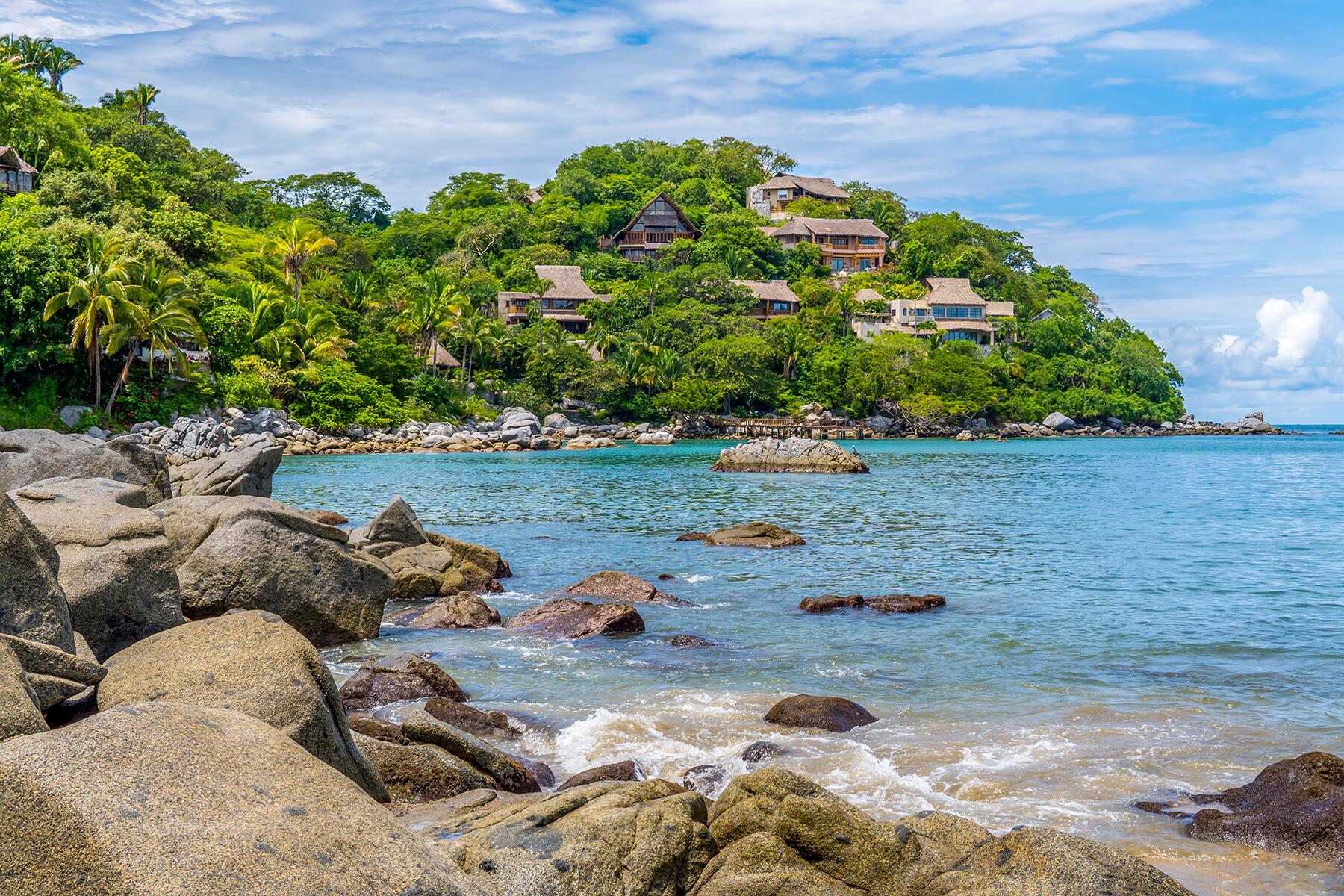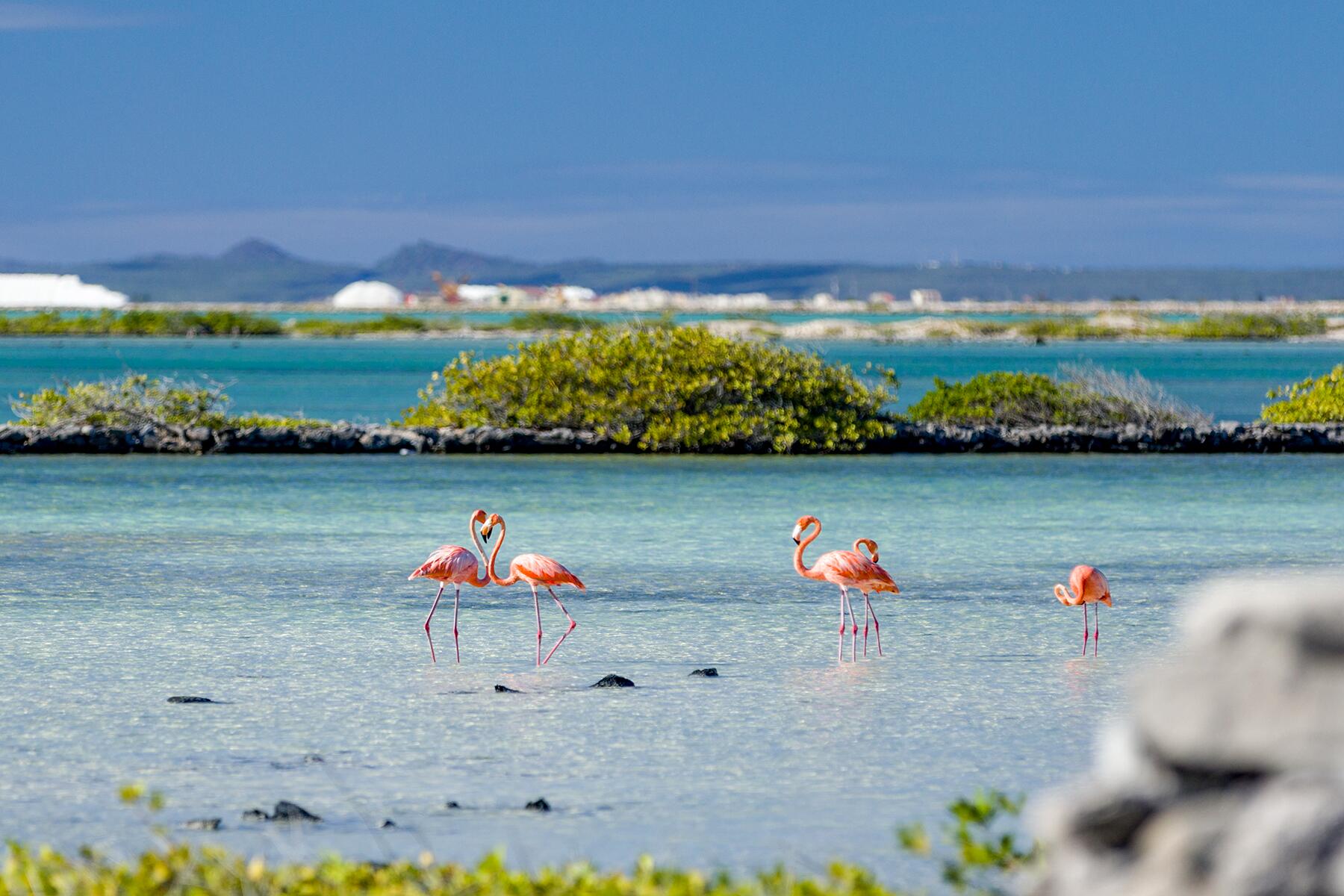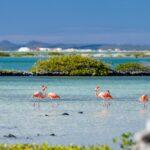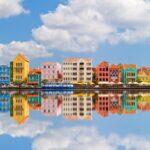
Mexico, Central America, & the Caribbean
Mexico, Central America, & the Caribbean

Top places to go in Mexico, Central America, & the Caribbean in 2023
Expand Full List







-
Bacalar, Mexico
![]()
-
Bonaire
![]()
-
Caye Caulker, Belize
![]()
-
Curaçao
![]()
-
Guanacaste Province, Costa Rica
![]()
-
Sayulita, Mexico
![]()
-
Semuc Champey, Guatemala
![]()



Bacalar
Mexico
While many people are still flocking to other Mexico hotspots, Bacalar, aptly named by locals the “Lagoon of Seven Colors,” is slowly climbing its way to the tops of travelers’ bucket lists. In the southeastern part of the country, not far from Belize’s border, Bacalar is designated as one of Mexico’s Pueblo Mágicos (Magic Towns). The tranquility of this quaint town, its mythical folklore, and mind-blowing natural wonders, easily support this official designation.
Beyond the magical feel, Bacalar gets points for its expansive lagoon with sections of sandbanks and shallow waters perfect for sitting and soaking it all in. Los Rapidos, Bacalar’s rippling rapids, are equal parts hypnotic and adrenaline-inducing. With over 26 miles of a freshwater lake, mangroves perfect for kayaking, and record-setting cenotes beckoning to be explored, Bacalar is an aquatic lover’s ultimate playground, despite the lack of an actual beach.
Bacalar Lagoon is reminiscent of every shade of bright-colored blue in a crayon box, glistening and glimmering thanks to the limestone-laden bedrock. It makes for epic explorations like wading through the warm knee-high waters in Canal de los Piratas (Pirate’s Channel) and Cocalitos, one of the many natural wonders in this magical town where you can see stromatolites (one of the oldest living organisms on earth). Bacalar is also home to Cenote Azul, one of the deepest cenotes in the region, which beckons swimmers, snorkelers, and even cavern divers (a guide is required).
A burgeoning gastronomy scene offers a range of cuisines from locally-inspired favorites such as xpelón tamales, a banana leaf-wrapped tamale stuffed with savory meats, or pan de cazón, a Mexican casserole-style dish made with layered tortillas and shark meat (typically dogfish shark). You also won’t find a shortage of vegan and international options in this eco-friendly town.
When in Bacalar, there’s no better place to stay than right off the lagoon, soaking up the blue skies and hot sun. Be surrounded by natural wonders and the unrushed rhythmic pace of nature at MÍA Bacalar Luxury Resort & Spa, or enchanting rustic vibes at Hotel Rancho Encantado, both just steps from the lagoon. Mi Kasa Su Kasa is a mid-range option with free paddleboards and kayaks for you to use at leisure. The Yak Lake House is an iconic hostel for budget travelers and backpackers and is excellent for meeting new friends, and offers tons of activities. The eco-friendly rooms, constructed out of converted concrete pipes, at Kuku Tubohostel provides another budget-friendly option in Bacalar.
Bacalar’s temperatures give summertime vibes year-round; however, as with many tropical destinations, it is subject to heavy rains during hurricane season, which spans from May to September. January through March and October through December are the best times to visit Bacalar.
Insider Tip
Bacalar is home to ancient stromatolites (around 3.5 billion years old). Always be mindful of these formations and careful not to damage them by sitting or standing on them.



Bonaire
Bonaire should be on everyone’s must-visit list. For starters, it’s the only country to acknowledge long-time returning visitors with Bronze, Silver, Gold, and Platinum ambassadorships—commemorative certificates for 10, 15, 20, or 30 years of consecutive trips. Fuchsia flamingos reportedly outnumber people, and wild donkeys roam the streets (free of traffic lights) on this protected marine park. Superb vistas of pink lakes and incredible world-class restaurants for refueling after a plunge in a pristine dive site—of which there are more than 60—add to the Dutch island’s appeal. Also noteworthy are Bonaire’s sustainability efforts, and in honor of Earth Day this year, the island invited visitors to promise to respectfully and responsibly enjoy the island, thereby launching the Bonaire Bond pledge.
Lucky visitors traveling in 2023 will have plenty of nature-focused activities to bookmark, including windsurfing lessons with world-champions Taty and Tonky Frans, breakfast and birding in Washington Slagbaai National Park with Bonaire Bird Photography Tours (binoculars included), and September’s annual swim to Klein Bonaire, the Caribbean’s largest uninhabited island.
Hotfoot it over to SENSES Boutique Hotel and Apartments, where details matter. Every suite and apartment is utterly unique, with quirky-yet-sleek adornments and ocean or garden views. Sorobon Beach Resort is a windsurf and wellness hotel that offers morning ocean yoga steps from jaw-dropping shallow azure waters. Delfins Beach Resort is a tried-and-tested favorite with oceanfront studios and villas and a celebrated pool bar called Club Tropicana.
Well outside the hurricane belt, Bonaire can be relied on for year-round fine weather and sunshine. Temperatures vary very little and even downpours during the rainy season (December through March) give way to sunny, blue skies before long. September is one of the warmest months, fortuitous for the outdoor national celebration of Dia di Boneiru (Flag Day) on the 6th of the month.
Insider Tip
Landsailing on blokarts—three-wheeled karts with sails—is a world of fun. From September 2023, Bonaire Landsailing will extend its hours and introduce night sailing so you’ll have no excuse not to race on these wind-driven wheeled yachts.



Caye Caulker
Belize
It should be unfathomable to encounter so many tropical wonders in one small country, but such is the allure of Belize. With blue lagoons, mangroves, mountains, and several hundred sandy islands and cays, the former British Honduras (which was officially renamed in 1973) is thoroughly deserving of a spot on your lust list; laid-back Caye Caulker is one of the country’s shiniest treasures. It’s here you can access the largest Barrier Reef in the Northern Hemisphere and blow bubbles alongside manatees, nurse sharks, and turtles as you snorkel and dive. Doing it all and doing nothing are equally appealing options on Caye Caulker, which is at once rollicking and rejuvenating.
Tourism has replaced coconuts and fishing as the main industries in Caye Caulker, but you can still enjoy minutes-fresh seafood and coconut-infused drinks at hot spots like The Lazy Lizard Bar & Grill at The Split—do also sample some Belizean rum and the much-loved national beer Belkin. In 2023, travelers will be able to pepper their days with lively events like the Caye Caulker Regatta in March, and July’s Lobster Fest, a delicious event rich with both sumptuous island views and fruits of the sea.
At Weezie’s Ocean Front Hotel and Garden Cottages, guests can make a splash in one of the three swimming pools, peel away stress during in-room massages, make use of complimentary kayaks and paddleboards, and stargaze on a dock when the day is done. On the north side of the island, El Ben Cabanas gets things started with a tropical welcome drink, followed by downtime in your palm-thatched cabana before dinner at the full-service on-site restaurant, T & T Bar and Grill.
You can expect clear skies and sunshine-bathed days if you visit between December and May during Belize’s dry season.
Insider Tip
There are no cars on Caye Caulker but bikes and golf carts are widely available for rent. To rent a golf cart, you must have a valid driver’s license on hand.



Curaçao
The “C” in the ABC islands (Aruba and Bonaire are the other two of these three westernmost islands of the Leeward Antilles in the Caribbean Sea) is charming, colorful, and culturally eclectic, with islanders who are seemingly fluent in every language under the sun. Though part of the Kingdom of the Netherlands, Curaçao is home to more than 50 nationalities, making it a prime prospect for culturally-minded travelers. Further sweetening the deal, the Dutch Caribbean island is majorly upping its game with a string of exciting new experiences and hotels.
Behold Curaçao’s legendary underwater world of deep reefs, which lured famed diver and ocean conservator Fabien Cousteau to strive to build the world’s first underwater research center on the island via a second-to-none submarine experience. U-Boat Worx has launched private submarines that comfortably accommodate up to three passengers.
Back on dry land, foodies may enjoy culinary delights with Dutch, West African, Caribbean, Spanish, and Venezuelan influences while exploring pastel-colored neighborhoods: poffertjes (a sweet pancake) and late-night parties in Pietermaai; Blue Curaçao drinks in the whitest sand on the legendary beaches (there are more than 35 to choose from); and quite literally tasting the world in the historic capital Willemstad, where you’ll have a dushi (“nice” in Papiamento) time with top-notch fusion cuisine.
Dreams Curaçao Resort, Spa & Casino in Piscadera Bay has something for everyone with a brewery, on-site dive center, themed events, and two white sand beaches. Recently opened Sandals Royal Curaçao invites paradise lovers to bask under the sun at its bi-level Dos Awa Infinity Pool, a brand first. Another fun perk, top-level suite guests are offered convertible Mini Coopers to cruise around the island in style. Champion poolside posers will be similarly impressed with Kontiki Beach Resort on bustling Mambo Beach—there are a whopping five swimming pools to choose from.
Curaçao doesn’t have a hurricane season, and it’s blissfully sunny all year with little annual rainfall. The only months to potentially avoid are December, January, and February during peak season when accommodation rates (and visitor numbers) surge.
Insider Tip
Don’t miss Curaçao Carnival in February when the island becomes a color show with floats, bands, beauty pageants, and homegrown Tumba music.



Guanacaste Province
Costa Rica
For travelers who wish to immerse themselves in the incredible biodiversity of Costa Rica, the province of Guanacaste is a prime destination thanks to a vibrant tourism industry, accommodations for all travel styles, and the accessibility of adventurous experiences that place the beauty and power of nature front and center.
Within Guanacaste, several national parks are spread across mineral-rich volcanic landscapes where hundreds of species of birds and animals thrive within dynamic ecosystems. Intrepid jungle excursions abound—thrill seekers can roar through white water rapids at Tenorio National Park, or slice through the rainforest on the La Selva Waterslide in Buena Vista Del Rincon. An up-river canyon trek beneath the Rincon de la Vieja volcano ends with plunges into refreshing azure pools and hot spring baths. ATV tours ramble fearless riders across hidden beaches and rocky mountain terrains, and novices can try their hand at navigating a kayak or stand-up paddleboard through dense, sultry mangrove forests where crocodiles linger on the banks.
Situated along the hot and dry Pacific Coast, Guanacaste is flanked with sun-soaked beaches where shy iguanas slink through soft white sand or multitudes of sea turtles emerge from their sandy nests at sunrise. Harnessing the forces of the ocean via a surfboard is one of the main draws to Guanacaste, and anywhere windswept waves are breaking offshore, there’s a surf school nearby.
The options for accommodation in Guanacaste run the gamut across travel styles and budgets. Most of Guanacaste’s luxurious digs are found on the Papagayo Peninsula, and range from all-inclusive brand-name resorts to exclusive, nature-adjacent experiences such as Kasiiya Papagayo Luxury Wilderness Retreat, where tented suites are perched cliffside or on the private beachfront. Ecolodges often deliver up-close wildlife encounters, and Tierra Madre Eco Lodge is right in the thick of it, offering only four jungle bungalows and a prime view of Lake Nicaragua. Communal eco-villages like PachaMama are a popular option for travelers looking to connect on a deeper level. Airbnb offers a tasty buffet of stylish stays—modern mountaintop villas, secluded open-air treehouses, and charming beachside casitas.
December to March is the dry season, when rain is rare and the sun stays shining. While the lack of rain is convenient, the downside is that conditions are dusty and dry out the plant life. April to November is the rainy season, but that shouldn’t be a deterrent—a few hours of afternoon showers can be beautiful to see, plus the air is fresh and the plants turn a glorious green.
Insider Tip
When flying to Guanacaste, skip San José entirely and book your flight into Liberia International Airport (LIR) for a far more convenient connection to the region.



Sayulita
Mexico
Palm-lined cobbled-stone streets sandwiched between cascading jungles on one side and golden beaches kissed by rolling tides on the other, it’s no wonder the word’s out about the not-so-sleepy pueblo on the Pacific coast. Since the 1960s, Sayulita’s warm waters and consistent waves have long attracted surfers, Hollywood stars, and musicians seeking ethereal escapism, but lately, it’s bringing in a new generation of visitors from artists, vagabonds, and digital nomads. Its surf culture remains intact. For those new to the sport, Sayulita Surf School offers lessons for all levels, in addition to paddleboarding.
Ease into your mornings with slow strolls through Sayulita’s Mercado Artesanal (dubbed the “Hippie Market”) for hand-crafted souvenirs, including jewelry, embroidered textiles, and a rainbow assortment of pom poms and woven handbags.
Spend listless afternoons lounging poolside at Punta Sayulita Beach Club or nestled under the shade of a palapa or palm tree on Sayulita beach or Playa de los Muertos (Beach of the Dead). A 15-minute drive north will take you to the cultural town of San Francisco, also widely known as San Pancho. It’s here you’ll find art galleries, vibrant street murals, and cultural community centers like the non-profit Entreamigos, where it’s possible to find non-Spanish speaking volunteer opportunities. This is also the home of the famous La Patrona Polo & Equestrian Club, which comes alive between November and May with its seasonal Sunday Funday brunch and polo match experience. Year-round you can experience a horseback riding tour, polo lessons, and/or attend a match.
Sayulita is known for its laid-back vibes and is affectionately called the “hippie town,” so you won’t find mega hotel chains and large luxury resorts here. Instead, small boutique hotels make up the accommodations in this coastal town. If beachfront and budget-friendly is what you’re seeking, Casa Love is one of the best budget options. To keep with the “love” theme, book a luxurious stay at Amor Boutique Hotel for world-class panoramic ocean views. For the best rooftop views in town, book a stay at Sayulinda Hotel.
Averaging 345 days of sunshine, Sayulita is a year-round destination, and there is never a wrong time to visit. After November and before April brings less humid weather and a quieter scene during the off-peak season. Some of the best surf breaks are created from December through April, making this the optimal time for surfers to visit.
Insider Tip
Whale mating season kicks off in December, but the best time for whale watching is in January and February when, if you get lucky, you can even spot the majestic creatures right from shore.



Semuc Champey
Guatemala
Guatemala, ranked as one of the top ten destinations for solo female travelers this year according to data from Hostelworld, is experiencing something of a travel boom. Semuc Champey—a heavenly combination of limestone bridges and emerald river pools with water from the Río Cahabón—is widely regarded as Guatemala’s most breathtaking sight and the natural wonder is thoroughly deserving of all its praise.
Tucked between dense jungle, Semuc Champey means “where the river hides” in the Indigenous language, Q’eqchi’. This paradisiacal natural bridge is 300 meters long, and the water is warm and welcoming for swimming. The colors oscillate between vibrant greens and turquoise depending on when you visit.
So what’s the catch? To get to Semuc Champey Natural Monument requires hours of twists, turns, bumps, on unpaved, unlit roads. The trip ultimately rewards you with a view that no photo can do justice, and it’s a vision that immediately makes clear the meandering journey was worth it. Within the national park, there are different trails that require varying degrees of exertion. The trail to the viewpoint (El Mirador) takes 45 tiring minutes but results in epic views of the jungle and waters below. The shorter Champey trail (roughly 20 minutes) leads you straight to the refreshing, ravishing waters.
You can either stay in the town of Lanquín or in one of the nearby jungle lodges, from which you can walk to Semuc Champey and be rocked to sleep by the sounds of nature after the arduous treks within the park. El Retiro Lodge in Lanquín has themed evenings and inviting hammocks for daytime downtime. Greengos Hotel is one of the closest accommodations to the park, and Utopia Eco Hotel has numerous ways to nourish your mind and body. There’s a cacao farm, yoga shala, a calisthenics gym, and it’s a mighty fine spot for river-tubing.
It’s best to make the once-in-a-lifetime trip during the dry season between December and April when the pools are clearer and there is less chance of a flood closing the park.
Insider Tip
Endeavor to arrive at Semuc Champey early in the morning to enjoy the scenery with fewer people as the tour groups arrive around lunchtime. Also, the river pools are slippery so bring sensible shoes.









































